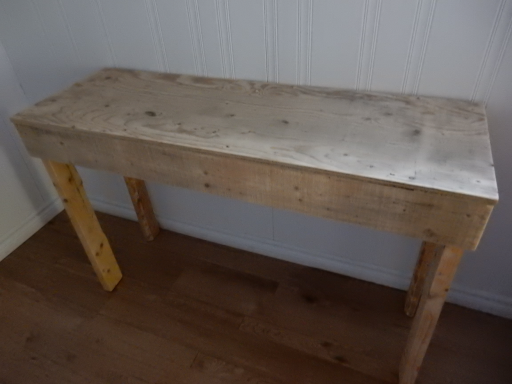- Wooden Table -
Synopsis
This tutorial will show you how to create a simple wooden table, four support planks under a rectangle slab to support the legs. I won't make it beautiful as I don't care and simply need something to put my electronics on.
Here are the dimensions I chose, you can ignore if you want.
Length: 50 inches
Width: 15 inches
Height: 32 inches
Tutorial
To start, get your supplies, I asked a friend if I could check around and see if they had appropriate supplies. We found two 2x4 lumbers & calculated that if we cut them to dimensions it would have been enough. I also found a decent-looking piece of wood that will be an adequate tabletop when cut. There were also relatively thin planks that I will use to reinforce the table.
Before cutting, write down the thickness of the piece of wood you will use as the tabletop. This is important as you will need to deduct that thickness off the length of your legs, otherwise you will exceed the dimensions you chose due to you deciding your dimensions before knowing what the specifications of your supplies were, you did that didn't you?
Use a try square to mark 90 degree angles with a pencil, you WILL fuckup without one. You can use a circular saw for good cuts but make sure your blade is not poorly aligned, alternatively you can use a hand saw but that requires more experience for straight cuts.
If you will use a hand saw you can use the proximal phalanx (the first row of finger bones in the hand) of your thumb to guide the blade, this reduces wobble. Do not rush and periodically blow the sawdust off to see if you are following the 90 degree line you drew with the try square.
Remember, periodically re-aligning the hand saw blade closest to 90 degrees vertically to cut is also important to reduce deviation.
After you've cut your supplies, I highly recommend you to sandpaper them for smooth surfaces and reducing the risk of splinters. Start with low grit sandpaper and gradually increase the grit rating.

In the image above you will see the supplies addressed somewhat competently. Note that my support planks are attached together with finishing nails and forms a rectangle with four planks, explaning this for clarity.
This rectangle should be aligned under the tabletop and more screws or nails should be used to secure the tabletop to the support structure.

If your support planks are not thick (like mine), I recommend using finishing nails as if you use "normal" screws they will break open your planks.
To proceed, take your legs and partly assembled table to level ground with no slope. If you've cut your legs straight you will have no problem aligning them over your table such that they be contained within each corner of the support rectangle and be level with the flat underside of the tabletop.
If you've chosen 2x4 lumbers like me for the legs, feel free to use 2 inch wood screws to secure the legs in place. I recommend first flipping the table upside down as to show the underside of the tabletop, placing the particular leg within the appropriate corner of the support planks and holding it there with your foot or hand for ease of screwing.
To make the structure stronger we decided on using three screws for each leg, two passing through the supports horizontally into the legs and one for the top of the table, going through the tabletop vertically down into the legs. This ensures that every surface is screwed together and stabilized.
If you don't want to scratch your floor you can get some furniture pads, those are typically at the dollar store, I personally used some and also placed two on the back so it doesn't make noise when making contact with the wall.
This table is strong, very lightweight and balanced, I can put all my weight on it without any problem and lifting it over my head with one hand is an easy task even though I'm not very strong, baaaah!

Fun Facts
Furniture made with plywood swells up when wet with water as it absorbs moisture, furniture made with particleboard will swell up even more. I've had this happen due to cold drinks causing air condensation and dripping water onto my old desk. Up until that day I thought coasters were just for show...
Wood is an organic material which means without appropriate maintenance it will rot. If things get out of hand fungi can even grow as some species feed off moist wood. I witnessed this firsthand on a small desk when assisting people clean out a building, the mushrooms were pretty.